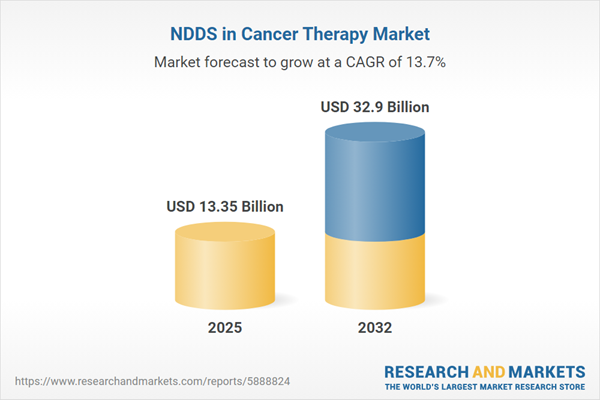Speak directly to the analyst to clarify any post sales queries you may have.
The oncology sector is experiencing a pivotal transition as advanced non-invasive drug delivery systems (NDDS) reshape cancer therapy management. Senior leaders must navigate increasing patient-centered demands while leveraging technological advancements for robust operational and strategic gains.
Market Snapshot: Global NDDS in Cancer Therapy Market
The global NDDS in Cancer Therapy Market is on a trajectory of strong expansion, with the sector registering a 13.72% compound annual growth rate (CAGR). This momentum is driven by advances in nanotechnology, leading to improved targeting precision and novel delivery vehicles in cancer treatment. As the adoption of NDDS technologies grows, executives face a shifting marketplace with heightened demands for clinical reliability and greater integration between research and commercial operations. The evolving environment calls for proactive operational adaptation and the strengthening of innovation pipelines to ensure a competitive edge as patient expectations and treatment standards rise.
Scope & Segmentation: Critical Insights for Executives
This report equips oncology decision-makers with a segmented, actionable analysis of the NDDS in Cancer Therapy market, supporting informed planning and strategic resource allocation. Key dimensions shaping the landscape include:
- Product Types: Dendrimers, exosomes, lipid nanocarriers, liposomes, metallic nanoparticles, micelles, nanoemulsions, and polymeric nanoparticles. These categories enable tailored cancer treatments and address varied therapeutic needs across oncology care.
- Drug Types: Gene-based therapies, monoclonal antibodies, oligonucleotide drugs, siRNA molecules, and chemotherapeutics. Each drug class supports advancements in precision medicine and multi-indication oncology protocols.
- Applications: Chemotherapy, immunotherapy, photodynamic therapy, radiotherapy, and other targeted methods. These applications emphasize personalization in cancer care and drive flexible management strategies.
- Technology Platforms: Implantable depot devices, injectable suspensions, microneedle arrays, and new nanotech-based solutions. These platforms enhance treatment precision, dosing consistency, and patient adherence.
- Regions: The Americas, Europe, Middle East & Africa, and Asia-Pacific. Each area presents unique regulatory and commercial dynamics, necessitating tailored entry and operational strategies.
- Key Companies: Johnson & Johnson, F. Hoffmann-La Roche Ltd, Pfizer Inc., Novartis AG, AstraZeneca PLC, Merck & Co., Inc., Bristol-Myers Squibb Company, Sanofi S.A., Amgen Inc., and AbbVie Inc. These industry leaders advance technology integration and global partnership activities across the NDDS landscape.
Key Takeaways for Senior Decision-Makers
- Personalized oncology is gaining momentum as nanotechnology enhances the accuracy and efficiency of treatment delivery, improving coordination between clinical and operational teams.
- Expanded collaborations with research organizations and technology developers are accelerating product validation cycles, enhancing the breadth of therapy portfolios and extending commercial reach in the oncology drug delivery space.
- Continuous changes in nanomedicine regulations require organizational flexibility, allowing companies to achieve and maintain compliance as international standards evolve.
- Strengthening oncology supply chains—including procurement strategies, diversified sourcing, and advanced inventory management—helps mitigate risks associated with regulatory uncertainty and market shifts.
- Integrating artificial intelligence and sophisticated analytics enhances decision-making, improves adaptive planning, and supports precise management of new cancer care models.
Tariff Impact: Addressing Oncology Supply Chain Shifts
Impending US tariffs in 2025 are projected to affect the availability of critical NDDS components such as specialty lipids, polymers, and metallic compounds. In response, industry leaders are implementing localized sourcing initiatives and building adaptable manufacturing systems. This strategic approach supports continued access to essential inputs, compliance with changing regulations, and long-term resilience across oncology supply chains.
NDDS in Cancer Therapy Market: Methodology & Data Sources
This analysis utilizes recent peer-reviewed publications, proprietary analytics, thorough patent reviews, and current policy assessments. Insights from oncology clinicians, technical experts, and experienced executives ensure the research aligns closely with the leadership needs of stakeholders across the oncology and drug delivery landscape.
Why This Report Matters
- Delivers comprehensive segmentation and technology evaluation focused on guiding research and development priorities, investment decisions, and resource allocation within cancer drug delivery.
- Enables executive teams to effectively steer compliance initiatives and adapt supply chain processes in response to evolving oncology and pharmaceutical regulations.
- Facilitates evidence-based strategy formation and ongoing performance monitoring, equipping leadership teams to foster innovation and quality in operational execution.
Conclusion: Strategies for Sustainable Advancement
Leading organizations that foster innovation in drug delivery, embrace regulatory adaptability, and invest in robust supply networks will be optimally positioned to drive enduring growth and operational excellence as the oncology sector continues to evolve.
Additional Product Information:
- Purchase of this report includes 1 year online access with quarterly updates.
- This report can be updated on request. Please contact our Customer Experience team using the Ask a Question widget on our website.
Table of Contents
3. Executive Summary
4. Market Overview
7. Cumulative Impact of Artificial Intelligence 2025
Companies Mentioned
The companies profiled in this NDDS in Cancer Therapy market report include:- Johnson & Johnson
- F. Hoffmann-La Roche Ltd
- Pfizer Inc.
- Novartis AG
- AstraZeneca PLC
- Merck & Co., Inc.
- Bristol-Myers Squibb Company
- Sanofi S.A.
- Amgen Inc.
- AbbVie Inc.
Table Information
| Report Attribute | Details |
|---|---|
| No. of Pages | 190 |
| Published | October 2025 |
| Forecast Period | 2025 - 2032 |
| Estimated Market Value ( USD | $ 13.35 Billion |
| Forecasted Market Value ( USD | $ 32.9 Billion |
| Compound Annual Growth Rate | 13.7% |
| Regions Covered | Global |
| No. of Companies Mentioned | 11 |









